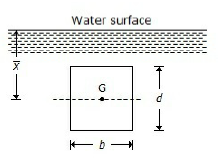In an immersed body, centre of pressure is
At the centre of gravity
Above the centre of gravity
Below be centre of gravity
Could be above or below e.g. depending on density of body and liquid
Correct Answer :
C. Below be centre of gravity
Related Questions
In an internal mouthpiece, the absolute pressure head at vena contracta is __________ the atmospheric pressure head by an amount equal to height of the liquid above the vena contracta.
Less than
More than
Equal to
None of these
A jet of water discharging from a 40 mm diameter orifice has a diameter of 32 mm at its vena contracta. The coefficient of contraction is
0.46
0.64
0.78
0.87
Choose the wrong statement
Any weight, floating or immersed in a liquid, is acted upon by a buoyant force
Buoyant force is equal to the weight of the liquid displaced
The point through which buoyant force acts, is called the center of buoyancy
Center of buoyancy is located above the center of gravity of the displaced liquid
The property by virtue of which a liquid opposes relative motion between its different layers is called
Surface tension
Coefficient of viscosity
Viscosity
Osmosis
The total head of a liquid particle in motion is equal to
Pressure head + kinetic head + potential head
Pressure head - (kinetic head + potential head)
Potential head - (pressure head + kinetic head)
Kinetic head - (pressure head + potential head)
Principle of similitude forms the basis of
Comparing two identical equipments
Designing models so that the result can be converted to prototypes
Comparing similarity between design and actual equipment
Hydraulic designs
According to the principle of buoyancy a body totally or partially immersed in a fluid will be lifted up by a force equal to
The weight of the body
More than the weight of the body
Less than the weight of the body
Weight of the fluid displaced by the body
In a free nappe,
The pressure below the nappe is atmospheric
The pressure below the nappe is negative
The pressure above the nappe is atmospheric
The pressure above the nappe is negative
Normal depth in open channel flow is the depth of flow corresponding to
Steady flow
Unsteady flow
Laminar flow
Uniform flow
The discharge through an external mouthpiece is given by (where a = Cross-sectional area of the mouthpiece, and H = Height of liquid above the mouthpiece)
0.855 a.√(2gH)
1.855 aH.√(2g)
1.585 a.√(2gH)
5.85 aH.√(2g)
The unit of dynamic viscosity in S.I. units is
N-m/s2
N-s/m2
Poise
Stoke
The pressure at a point 4 m below the free surface of water is
19.24 kPa
29.24 kPa
39.24 kPa
49.24 kPa
The property of a fluid which enables it to resist tensile stress is known as
Compressibility
Surface tension
Cohesion
Adhesion
Water is a __________ fluid.
Real
Ideal
Newtonian
Non-Newtonian
The flow in a pipe is neither laminar nor turbulent when Reynold number is
Less than 2000
Between 2000 and 2800
More than 2800
None of these
The discharge through a wholly drowned orifice is given by (where H1 = Height of water (on the upstream side) above the top of the orifice, H2 = Height of water (on the downstream side) above the bottom of the orifice, and H = Difference between two water levels on either side of the orifice)
Q = Cd × bH₁ × √(2gh)
Q = Cd × bH2 × √(2gh)
Q = Cd × b (H2 - H1) × √(2gh)
Q = Cd × bH × √(2gh)
The value of bulk modulus of a fluid is required to determine
Reynold's number
Froude's number
Mach number
Euler's number
A piece of metal of specific gravity 7 floats in mercury of specific gravity 13.6. What fraction of its volume is under mercury?
0.5
0.4
0.515
0.5
In a forced vortex, the velocity of flow everywhere within the fluid is
Maximum
Minimum
Zero
Nonzero finite
The horizontal component of buoyant force is
Negligible
Same as buoyant force
Zero
None of the above
The viscosity of water is __________ than that of mercury.
Higher
Lower
Same as
None of these
The hydraulic mean depth for a circular pipe of diameter (d) is
d/6
d/4
d/2
d
A structure used to dam up a stream or river over which the water flows is called
Orifice
Notch
Weir
Dam
The siphon will work satisfactorily, if the minimum pressure in the pipe is __________ vapour pressure of liquid.
Equal to
Less than
More than
None of these
The value of coefficient of discharge is __________ the value of coefficient of velocity.
Less than
Same as
More than
None of these
The magnitude of water hammer depends upon the
Elastic properties of the pipe material
Elastic properties of the liquid flowing through the pipe
Speed at which the valve is closed
All of the above
The value of coefficient of velocity for a sharp edged orifice __________ with the head of water.
Decreases
Increases
Remain same
None of these
Which of the following manometer has highest sensitivity?
U-tube with water
Inclined U-tube
U-tube with mercury
Micro-manometer with water
Metacentric height is the distance between the metacentre and
Water surface
Center of pressure
Center of gravity
Center of buoyancy
A vertically immersed surface is shown in the below figure. The distance of its centre of pressure from the water surface is 
(bd²/12) + x
(d²/12 x) + x
b²/12 + x
d²/12 + x
